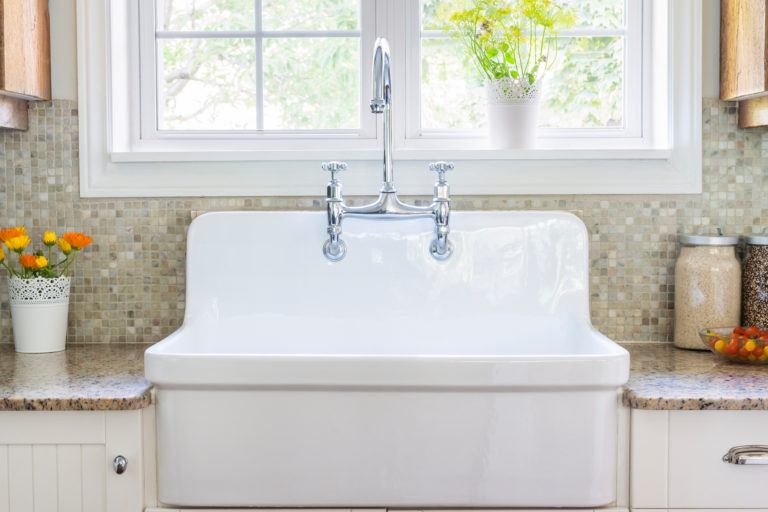
Quick Tips
- Start by cleaning the sink with white vinegar to disinfect and remove surface grease and grime.
- Follow the instructions on the package of oxygen bleach to mix your cleaning solution.
- Set the bowl next to the sink and soak a rag or two in the oxygen bleach solution.
- Let the rags sit in the sink undisturbed for 15 minutes.
- Remove the rags and scrub the whole sink with a brush, concentrating on any stubborn stains.
- Rinse the sink well with clean water and allow it to air dry.
What color is your porcelain sink? Until recently, mine was shades of coffee, tea, tomato sauce, Jello, and pan-fried chicken. Brownish. Splotchy. Disgusting. Porcelain kitchen sinks are supposed to be white, and when they are, they look great: clean, crisp, and bright. But porcelain sinks stain easily, and most people use some form of bleach to clean them. If you’re trying to clean green, chlorine bleach is probably on your list of products to avoid.
There is an extremely effective environmentally friendly alternative to chlorine bleach, though. It’s marketed as oxygen bleach, but the natural, non-toxic, biodegradable compound that does the work is sodium percarbonate. It’s best known as the magic ingredient in OxiClean, but it’s also available under different name brands and in various concentrations. Oxygen bleach is more expensive than chlorine bleach, and can take longer to work, but what it costs in time and money is more than repaid in safety for the environment and your health.
Steps to Cleaning a Porcelain Sink
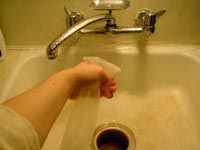 Start by cleaning the sink with white vinegar to disinfect and remove surface grease and grime. I use a spray bottle of pure vinegar to soak the sink and faucet, then go over them with a scrub brush before rinsing with water. If your sink isn’t stained, you can stop after this step, but if you need to continue with oxygen bleach to whiten the sink, make sure you rinse the vinegar away thoroughly.
Start by cleaning the sink with white vinegar to disinfect and remove surface grease and grime. I use a spray bottle of pure vinegar to soak the sink and faucet, then go over them with a scrub brush before rinsing with water. If your sink isn’t stained, you can stop after this step, but if you need to continue with oxygen bleach to whiten the sink, make sure you rinse the vinegar away thoroughly.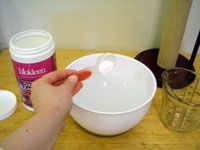 Follow the instructions on the package of oxygen bleach to mix your cleaning solution. Pre-mixed oxygen bleach solutions are available, but they’re usually made with hydrogen peroxide instead of sodium percarbonate and aren’t highly concentrated. As a result, they don’t whiten as effectively as homemade solutions of powdered oxygen bleach and water.
Follow the instructions on the package of oxygen bleach to mix your cleaning solution. Pre-mixed oxygen bleach solutions are available, but they’re usually made with hydrogen peroxide instead of sodium percarbonate and aren’t highly concentrated. As a result, they don’t whiten as effectively as homemade solutions of powdered oxygen bleach and water.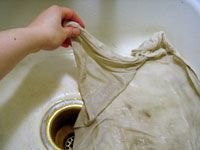 Set the bowl next to the sink and soak a rag or two in the oxygen bleach solution. Without squeezing any of the liquid out of the rags, transfer them to the sink and lay them flat across the stained portion of the sink. In my case, this was just the bottom and a ring along the sides, near the bottom. If the sides of your sink are stained higher up, you can drape a saturated rag over the edge of the sink and let it hang down against the inside.
Set the bowl next to the sink and soak a rag or two in the oxygen bleach solution. Without squeezing any of the liquid out of the rags, transfer them to the sink and lay them flat across the stained portion of the sink. In my case, this was just the bottom and a ring along the sides, near the bottom. If the sides of your sink are stained higher up, you can drape a saturated rag over the edge of the sink and let it hang down against the inside.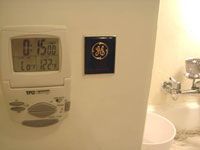 Let the rags sit in the sink undisturbed for 15 minutes.Oxygen bleach works basically by breaking apart the chemical bonds holding the stains together. This reaction takes a little bit of time, and gives you a chance to multitask or drink a soda.
Let the rags sit in the sink undisturbed for 15 minutes.Oxygen bleach works basically by breaking apart the chemical bonds holding the stains together. This reaction takes a little bit of time, and gives you a chance to multitask or drink a soda.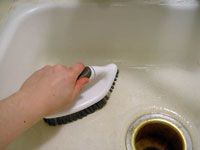 Remove the rags and scrub the whole sink with a brush, concentrating on any stubborn stains. Feel free to skip this step if your sink looks gloriously white when you lift the rags. There were still a couple of dingy spots in mine, but the scrub brush lifted those right up.
Remove the rags and scrub the whole sink with a brush, concentrating on any stubborn stains. Feel free to skip this step if your sink looks gloriously white when you lift the rags. There were still a couple of dingy spots in mine, but the scrub brush lifted those right up.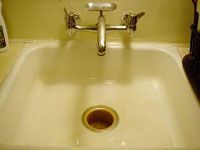 Rinse the sink well with clean water and allow it to air dry. My kitchen sink was such a bright white after I finished this process that it took me a few days to get used to it. Unfortunately, oxygen bleach can’t do anything about the crappy lighting in my kitchen that makes this picture a bit unconvincing.
Rinse the sink well with clean water and allow it to air dry. My kitchen sink was such a bright white after I finished this process that it took me a few days to get used to it. Unfortunately, oxygen bleach can’t do anything about the crappy lighting in my kitchen that makes this picture a bit unconvincing.
Why Not Use Chlorine Bleach?
Chlorine bleach, or more precisely sodium hypochlorite, has a nasty reputation that it doesn’t entirely deserve. But with oxygen bleach available as a great alternative for household disinfecting, stain removal, and whitening, it doesn’t hurt to keep your home free of chlorine bleach and the risks that can accompany it. Chlorine bleach contains corrosive chemicals that will burn through fabrics and other materials—including skin—if given the chance. It also causes irritation to the eyes, nose, throat, and lungs and must be used in a well-ventilated area, especially by those with asthma or other respiratory disorders. If chlorine bleach is inadvertently mixed with acids present in vinegar or other cleaning solutions, it releases carcinogenic dioxins and chlorine gas, which is so harmful it’s used in chemical warfare. If it comes into contact with ammonia in urine or household cleaners, chlorine bleach will release chloramines that can lead to difficult breathing. During typical household use, bleach breaks down primarily into harmless salt water and oxygen, but it also releases a small amount of chlorine, which in much larger quantities is dangerous for both humans and wildlife.
Cleaning Porcelain Naturally
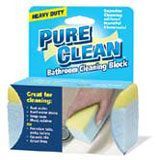 PureClean Bathroom Block is a unique porcelain cleaner made from recycled glass that has been ground into a fine powder. It is designed to scrub effectively without using chemicals or scratching the surface.
PureClean Bathroom Block is a unique porcelain cleaner made from recycled glass that has been ground into a fine powder. It is designed to scrub effectively without using chemicals or scratching the surface.
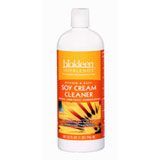 BioKleen Soy Cream Cleaner relies on grains of perlite, a volcanic rock, to scrub stains away without scratching delicate surfaces. You can order Biokleen from Amazon.
BioKleen Soy Cream Cleaner relies on grains of perlite, a volcanic rock, to scrub stains away without scratching delicate surfaces. You can order Biokleen from Amazon.
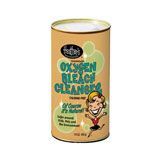 Heather’s Oxygen Bleach Cleanser combines sodium percarbonate with other natural, biodegradable ingredients to clean porcelain and other white surfaces safely and effectively.
Heather’s Oxygen Bleach Cleanser combines sodium percarbonate with other natural, biodegradable ingredients to clean porcelain and other white surfaces safely and effectively.